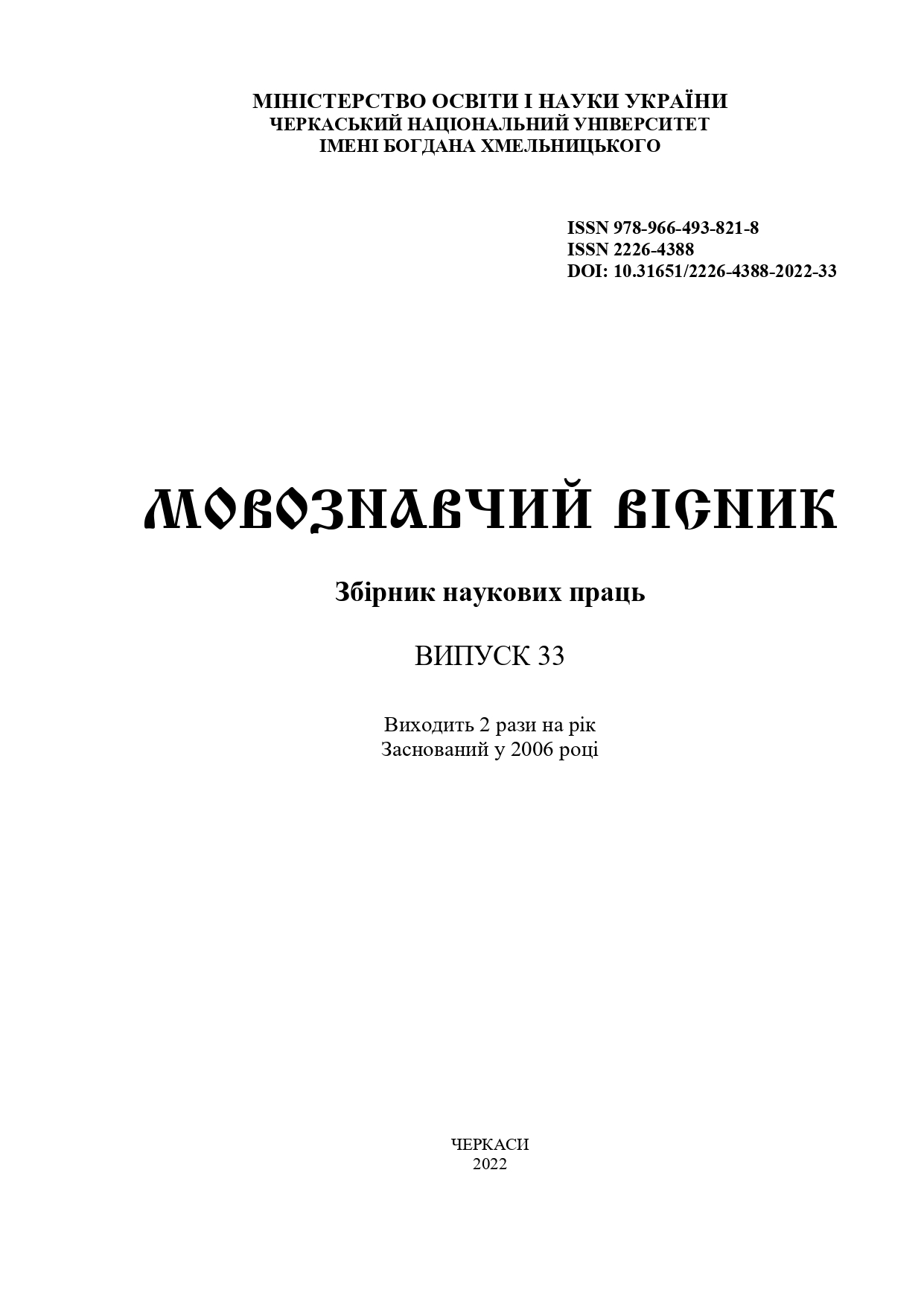THE LANGUAGE OF WAR IN THE CONTEMPORARY DOCUMENTARY PROSE
Main Article Content
Abstract
Introduction. Despite mankind’s persistent attempts to historicize the war as a phenomenon, it has not disappeared either from the “radars” of our memory, neither from family stories, nor from the collective, national consciousness over the past half century. The memory of the war is also present in everyday informational and political discourses. These discourses of war have formed a special culture of the wound in the humanitarian space. For several decades it has been actively searching for
mechanisms to work through the trauma not only of those who have experienced it, but also of new generations who in various ways permanently feel the threat of the inevitable influence of the past. This threat manifested itself especially sharply in the Russian-Ukrainian war, which began in the spring of 2014 in Donbas. In February 2022 it transformed into a full-scale Russian military invasion of Ukraine.
Purpose. The proposed study is an attempt at a scientific interpretation of the literary text as a tool for mastering the language of the new reality in the conditions of the war in Donbas. The author of the study tries to find out the mechanism for creating the artistic language of war.
Results. In the context of a full-scale military intervention, this case of the cultural representation of a traumatic experience seems not only relevant but also necessary. The works of modern Ukrainian writers, whose literary experience is gained precisely on the battle fronts, become the main object of the research. This is especially important in studying the process of recover from the traumatic experiences.
The author of the article tries to find out the peculiarities of literature as an important socio-cultural mechanism of creating the language of war using the example of the documentary prose of soldiers Valeria Burlakova (Life of P.S.) and Valerii Ananiev (Footprints on the Road). Originality. Attempts of Ukrainian culture to read important fundamental codes of the past are actively demonstrated by cultural texts, among which literature has a symbolic mission. Such texts reveal the lost motives of our historical memory and provide an opportunity to understand the causes of modern events. In addition to the aestheticization of reality and its artistic interpretation, the modern artistic text forms the language of actual reality. In this language we discover both the search for lost contents of the past and the detailed record of traumatic events in the present.
Conclusion. Such literature prioritizes the documentary genre, emphasizing sincerity rather than an attempt to present an alternative reality. However, we consider this phenomenon in a broader context than just a philological one. The language of the contemporaryliterary work appears at the same time as a psychological, historical and social category, because the considered texts illustrate that it becomes a tool for visualizing and searching for the meaning of war.
Article Details
References
Ananiev, Valerii (2019). Slidy na dorozi [Steps on the Road]. 4-te vyd. Kamianets-Podilskyi: Vyd.
Hordukova I. Ye., 376 (in Ukr.).
Białecka, A. (2014). Ekspresja lteracka jako strategia przetrwania po traumie. Doświadczenie Aushwitz
w literaturze kobiecej. In: Kobiety wojny. Między zbrodnią a krzykiem o godność / red. A. Bartuś. Oświęcim, 249–256 (in Pol.).
Burlakova, V. (2016). Zhyttia P. S. [Life P. S.] Kyiv: Tempora, 184 (in Ukr.).
Erll, A. (2008). Literature, film, and the mediality of cultural memory. Cultural memory studies. An
international and interdisciplinary handbook / Ed. by A. Erll & A. Nu ̈nning. Berlin – New York : De Gruyter, 389–398 (in Eng.).
Felman, Sh. & Laub, D. (1992). Testimony: Crises of Witnessing in Literature, Psychoanalysis and
History. New York, 296 (in Eng.).
Gilmore, L. (2015). Przypadki graniczne: trauma autoreprezentacja i prawne formy tożsamości. In:
Antologia studiów nad traumą / pod red. Tomasza Łysaka. Kraków, 359–375 (in Pol.).
Horbulina, V. P. (Ed.) (2017). Svitova hibrydna viina: ukrainskyi front [Global hybrid war: the
Ukrainian front]. Kyiv: NISD, 496 (in Ukr.).
Hunt, N. C. (2010). Memory, War and Trauma. New York : Cambridge University Press, 232 (in Eng.).
Huyssen, A. (2000). Of mice and mimesis: Reading Spiegelman with Adorno. In: New German
Critique, 81, 65–82 (in Eng.).
LaCapra, D. (2009). Historia w okresie przejściowym. Doświadczenie, tożsamosć, teoria kryryczna.
Tłum. K. Bojarskiej. Kraków, 347 (in Pol.).
Parakhonskyi, B. & Yavorska, H. (2019). Ontolohiia viiny i myru: bezpeka, stratehiia, smysl:
monohrafiia [An Ontology of the War and Peace: security, strategy and sense]. Kyiv: NISD, 560 (in Ukr.).
Shevchuk, Yu. Pro viinu i potrebu novoi movy [About the war and the need for a new language].
Available at: https://www.radiosvoboda.org/a/mova-maye-znachennya/31750018.html (in Ukr.).
Van der Kolk, B. (2020). Telo pomnit vse: kakuyu rol’ psihologicheskaya travma igraet v zhizni
cheloveka i kakie tekhniki pomogayut [The Body Keeps the Score: Brain, Mind, and Body in the Healing of
Trauma] / Perev. I. Chornyj. Moskva: Bombora, 464 (in Russ.).
Yavorska, H. (2015). Mova viiny yak skladova konfliktu (shliakhy transformatsii ukrainskoho
mediinoho dyskursu) [The language of war as a component of the conflict (ways of transforming the Ukrainian
media discourse)]. In: Stratehii transformatsii i preventsii prykordonnykh konfliktiv v Ukraini. Zbirka analitychnykh
materialiv [Strategies of transformation and prevention of border conflicts in Ukraine. Collection of analytical
materials]. Lviv: Halytska vydavnycha spilka, 366–398 (in Ukr.).

